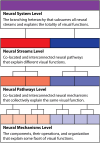What Is a Visual Stream?
- PMID: 38820554
- PMCID: PMC11602008
- DOI: 10.1162/jocn_a_02191
What Is a Visual Stream?
Abstract
The dual stream model of the human and non-human primate visual systems remains Leslie Ungerleider's (1946-2020) most indelible contribution to visual neuroscience. In this model, a dorsal "where" stream specialized for visuospatial representation extends through occipitoparietal cortex, whereas a ventral "what" stream specialized for representing object qualities extends through occipitotemporal cortex. Over time, this model underwent a number of revisions and expansions. In one of her last scientific contributions, Leslie proposed a third visual stream specialized for representing dynamic signals related to social perception. This alteration invites the question: What is a visual stream, and how are different visual streams individuated? In this article, we first consider and reject a simple answer to this question based on a common idealizing visualization of the model, which conflicts with the complexities of the visual system that the model was intended to capture. Next, we propose a taxonomic answer that takes inspiration from the philosophy of science and Leslie's body of work, which distinguishes between neural mechanisms, pathways, and streams. In this taxonomy, visual streams are superordinate to pathways and mechanisms and provide individuation conditions for determining whether collections of cortical connections delineate different visual streams. Given this characterization, we suggest that the proposed third visual stream does not yet meet these conditions, although the tripartite model still suggests important revisions to how we think about the organization of the human and non-human primate visual systems.
No rights reserved. This work was authored as part of the Contributor's official duties as an Employee of the United States Government and is therefore a work of the United States Government. In accordance with 17 U.S.C. 105, no copyright protection is available for such works under U.S. Law.
Figures


References
-
- Bechtel, W. (2019). Resituating cognitive mechanisms within heterarchical networks controlling physiology and behavior. Theory & Psychology, 29, 620–639. 10.1177/0959354319873725 - DOI
MeSH terms
Grants and funding
LinkOut - more resources
Full Text Sources

